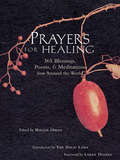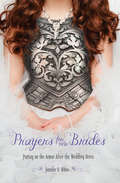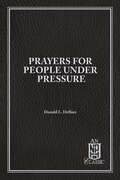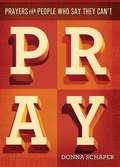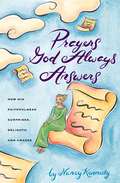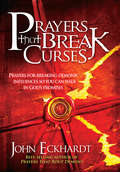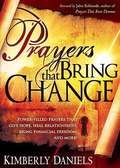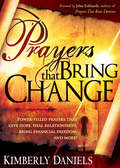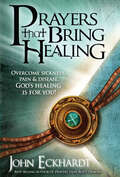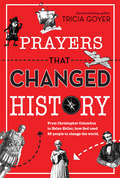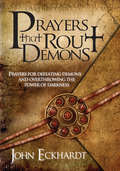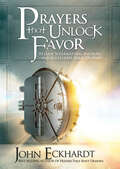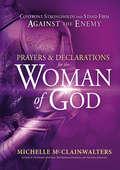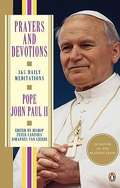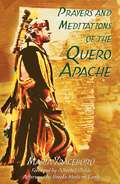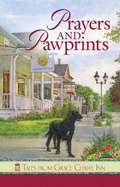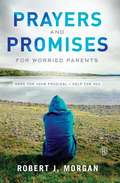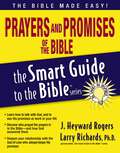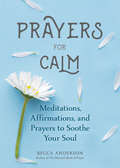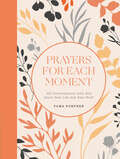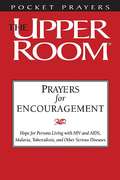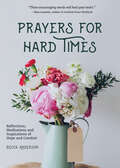- Table View
- List View
Prayers For Healing: 365 Blessings, Poems, & Meditations from Around the World
by Maggie OmanAs recent scientific research shows, the simple act of praying can be emotionally, spiritually, and even physically healing. With Prayers for Healing, Maggie Oman invites readers into the healing space she has created within the pages of this daybook to reap its benefits in times of stress, illness, depression, or spiritual longing. With inspiration from such diverse sources as the Tao Te Ching, the Koran, the Torah, Native American texts, and the Bible, contributors include Thich Nhat Hanh, Wendell Berry, Jack Kornfield, Rumi, Rainer Maria Rilke, Marian Wright Edelman, Martin Luther King, Jr. , and Marianne Williamson, providing comfort and inspiration on the journey toward rejuvenation and renewal.
Prayers For New Brides: Putting On God's Armor After The Wedding Dress
by Jennifer WhiteA new wife is seldom aware of the intense spiritual battle threatening her dreams of happily ever after. Often, she enters the marriage without the benefit of great examples, biblical knowledge, and mentors offering godly wisdom. The battle begins and she is unarmed. Can she survive? Will her marriage become another divorce statistic? Marriage is God's design. He has a battle plan, the power and the resources to win. When a wife knows who God is and what He can do, she can trust Him to sustain her and her marriage. Her joy will be complete as she allows Him to empower her to do more for her union than she can imagine.
Prayers For People Under Pressure (NPH Classics)
by Donald DeffnerHow do Christians deal with stress and the pressures of life?Daily events often cause great stress. A fight with your spouse, a medical procedure, a school exam, a conflict with a coworker, a death in your family—these all bring about stress, anxiety, and worry.The scriptural meditations in Prayers for People Under Pressure will encourage you to prepare for, cope with, and put to rest your daily stress.With Christian prayers and references to Bible verses, this book will help you dig deeper into God’s Word and find comfort for all of your troubles!
Prayers For People Who Say They Can't Pray
by Donna SchaperAlmost everyone prays: believers, unbelievers, wanna-be believers and might-have-been believers. It assures us all in our many parts and many moods that everything is going to be okay, despite any evidence to the contrary. When people say "I don’t know how to pray," what they often mean is "I don’t believe." Or perhaps they are struggling with disappointment or anger with God and have taken a break from their prayer life. This book is written to remove these obstacles to prayer and to show how honest prayer doesn’t require belief or trust nor does it need constant satisfaction. This book introduces new ways of prayer and thinking about what prayer is--to offer the reader a new experience because sometimes our heart has a wisdom that our head does not. Whether you are someone who believes, hopes to believe, almost believes or simply trusts that offering a prayer means something, this book is for you.
Prayers God Always Answers: How His Faithfulness Surprises, Delights, and Amazes
by Nancy Kennedy"I have a secret prayer," confesses humorist Nancy Kennedy. "Every night before I go to sleep, I pray that I will wake up with a body like Cindy Crawford's...that the pile of Hershey kisses I ate won't go directly to my thighs...that one day someone will push a refrigerator-size check in my face and say, 'You've just won 11 million dollars!'" But Kennedy has also prayed for "nobler" things - like patience, strength, and a deeper trust in God. But, as she's found, prayers are not always answered in the way one expects. Like many others, she has wondered: "Why do I sometimes get immediate answers to my prayers, completely unexpected answers to others, and occasionally no answer at all? What can I legitimately pray for, according to the Bible? Will God respond to my prayers if I lack faith that He'll answer? Does God even need my prayers, since He must know what He wants to do already? With lighthearted humor and godly wisdom, Nancy Kennedy explores readers' most burning questions about prayer, solving a great deal of the mystery through an examination of those wonderful prayers God always answers: ones that lovingly conform us to the image of Christ.From the Trade Paperback edition.
Prayers That Break Curses: Prayers for Breaking Demonic Influences so You Can Walk in God's Promises
by John EckhardtIs your life characterized by continual setbacks and misfortune? Does it appear as though no matter what you do, you cannot seem to obtain the blessings of the Lord? You could be living under a curse. Unfortunately, there are still many believers living under curses even though they have been legally redeemed. Just as a believer may have to fight a good fight of faith for healing, he or she may also have to fight a good fight of faith against curses. Satan may not have a legal right to enforce a curse against you, but he is an outlaw and will attempt to do so anyway. Therefore, curses oftentimes have to be broken, and you must learn how to stand in faith against those curses, keeping them from operating in your life. The promises God gives us in the Bible are not automatic. They must be believed and often fought for. You don&’t have to fight God for His promises; He is not keeping them back from you. But you must contend with the Adversary who is trying to prevent you from receiving and walking in God&’s promises. Written in the style of Prayers That Rout Demons, this second book in the series contains information about curses and sentence declaratory prayers to break the power of curses from your life.
Prayers That Bring Change
by Kimberly DanielsUse the authority God has given you to move to the next level in your prayer life with this collection of prayers by best-selling author Kimberly Daniels. More than just a book on how to pray, Prayers That Bring Change is filled with actual prayers based on biblical principles that will help you live victoriously in every situation you face. Included are prayers for... Your marriage and other relationships, The economy and your finances, Revival in your community, Generational blessings. Learn to break the powers of darkness and release the blessings and favor of God in your life.
Prayers That Bring Change: Power-Filled Prayers that Give Hope, Heal Relationships, Bring Financial Freedom and More!
by Kimberly DanielsUse the authority God has given you to move to the next level in your prayer life with this collection of proclamation prayers by best-selling author Kimberly Daniels. More than just a book on how to pray, Prayers That Bring Change is filled with actual prayers based on biblical principles that will help you live victoriously in every situation you face. Learn to break the powers of darkness and release the blessings and favor of God in your life.
Prayers That Bring Healing: Overcome Sickness, Pain, and Disease. God's Healing is for You!
by John EckhardtIn his new book Prayers That Bring Healing, John Eckhardt wants you to know that no matter what your sickness, no matter who you are, it is God&’s will for you to live a full, healthy, disease-free life. When Jesus came to a town preaching the coming of the kingdom of God, not only did He heal everyone who came to Him but he also healed &“all manner of sickness.&” This means that there is no sickness, disease, or infirmity God can&’t or won&’t heal. When the doctors tell you that you have an incurable disease, know that it is not incurable for Jesus. There is nothing too hard for God. In this book you will discover twelve ways healing takes place. They include: •Healing through the laying on of hands (Luke 4:40) •Healing through deliverance (Matt 8:16) •Healing through breaking curses (Gal. 3:13 •Healing through anointing oil (Mark 6:1) •Healing through faith (Mark 11:23) Healing through prayer (Matt 21:22)
Prayers That Changed History: From Christopher Columbus to Helen Keller, How God Used 25 People to Change the World
by Tricia GoyerOne prayer can change everything. Martin Luther. Sojourner Truth. Helen Keller. St. Patrick. We read their stories, and of other people like them, in history books, and hear about the amazing things they did to change the world. But one part of the story is often left out: Each one of them wouldn’t have accomplished what they did without prayer. In this book from bestselling author Tricia Goyer, the stories of twenty-five notable people are presented along with the major prayer that changed their lives, and changed history. Following each historical example is a biblical story that ties to that person’s life and actions, as well as ways you can use the power of prayer in your life as well. Because God isn’t done changing the world yet, and he would love to use you to make history. Includes images of each historical figure.
Prayers That Rout Demons: Prayers for Defeating Demons and Overthrowing the Powers of Darkness
by John EckhardtThis book contains powerful warfare prayers and decrees taken from Scripture that will break the powers of darkness and release the blessings and favor of God. This prayer tool includes an introduction to spiritual warfare and biblical principles for praying to overcome demonic influence and oppression.Readers will learn specifically how to release the fire of the living God to:· Preach· Prophesy· Heal the sick· Cast out demons
Prayers That Unlock Favor: Release Supernatural Increase and Accelerate Your Destiny
by John EckhardtFROM THE AUTHOR OF more than forty books, including Prayers That Rout Demons and Deliverance and Spiritual Warfare Manual:Your future is determined by your openness to God&’s supernatural plan. This book will prepare your heart to expectantly wait on God and hope for all He has promised. You will no longer be bound by past failures and disappointments. Instead, you will have the confidence that He is faithful to do exactly what He said He would. Are you struggling in life, frustrated and in need of breakthrough? You can walk in the favor and blessing of God. John Eckhardt shows you how to position yourself for breakthrough and receive the supernatural wisdom and favor of God. Filled with powerful prayers and declarations, Prayers That Unlock Favor and Increase will help you do the following: Discover the foundation to receiving God&’s favor Walk in the covenant blessing of obedience Harness your future with expectancy Break the powers of darkness, and step into the plan of success God has already marked for you!
Prayers and Declarations for the Woman of God: Confront Strongholds and Stand Firm Against the Enemy
by Michelle McClain-WaltersExpanding upon the declarative prayers found in the best-selling books by Michelle McClain-Walters, Prayers and Declarations for the Woman of God shows how to confront strongholds, cancel the assignments of the enemy, and accomplish mighty exploits for God's kingdom. Within the pages of this book, women will find ways to activate anointings similar to those of the Bible's most daring heroines. Bolstered with additional, exclusive content, Prayers and Declarations for the Woman of God is a well-rounded guide addressing topics relevant to women today. McClain-Walters brings you the ultimate resource for women who yearn to be bold leaders in ministry, in the home, and in personal relationships.
Prayers and Devotions
by John Paul Peter Canisius Johannes van LiThis treasury of selected passages from the writings and addresses of perhaps the most impressive leader of the Catholic Church the world has ever known offers, as its editor suggests, "a harvest from the mind and heart of Pope Wojtyla." And so here is a chance for the modern reader, engaged in various daily tasks, to spend a few moments with the Pope each day of the liturgical year, contemplating his reflections on the mystery and the example of Christ; and on the church, man, the family, the lives of the saints, the meaning of holidays, and the place of faith in daily life. His personal concerns as expressed in these passages include such topics as "Sharing with Others," "To Be in Peace," "Consumer Society," "Family Prayer," and "The Great Divine Trial," about the meaning of his near-assassination. Through these pages of calm reflection each day of the year, all will find a moment of peaceful repose from the occupations of life.
Prayers and Meditations of the Quero Apache
by Brooke Medicine Eagle Alberto Villoldo Maria YracébûrûTeaches the traditional Quero Apache meditative practice of entering the silence--a combination of prayer, meditation, and breathwork--as a path to spiritual healing and enlightenment • Contains 24 prayer wheels from the Quero Apache tradition• Offers easy-to-follow instructions for how to conduct the practice• Provides rare insights into the spiritual philosophies and rituals of the Quero Apache• Written by a living descendant of Apache prophet NochaydelklinneThe Quero Apache Snake Clan, or Tlish Diyan, center their spiritual practice on the daily ceremony of Doowaa-gon’ch-aada, “entering the silence.” A combination of meditation, breathwork, and prayer, Doowaa-gon’ch-aada offers an experiential connection to All That Is from the Earth-based spiritual traditions of indigenous America. When performed properly, this ritual becomes a path to self-realization and transcendence.Prayers and Meditations of the Quero Apache explains how to establish a personal practice. In addition to 24 prayer wheels, easy-to-follow instructions for the ritual, and accompanying pieces of inspirational artwork, the book includes a rare overview of the spiritual philosophies of the Quero Apache. The author incorporates her own stories and essays into the text in order to share the wisdom she has gained as daughter of the Tlish Diyan, granddaughter and apprentice of Apache holy man Ten Bears, and descendant of the prophet Nochaydelklinne.
Prayers and Pawprints (Tales from Grace Chapel Inn #16)
by Diann HuntOnce readers visit the charming village of Acorn Hill, they'll never want to leave. Three sisters -- Louise, a widow from Philadelphia; Alice, a nurse who lived with her father; and Jane, a chef from San Francisco -- reunite in the sleepy town after their father's death and turn the family home into a charming bed-and-breakfast. Here the sisters rekindle old memories, rediscover their childhood bonds, revel in the blessings of friendship, and meet fascinating guests along the way. When two very special dogs descend on Acorn Hill, Alice wonders, Could a dog be an answer to prayer? Alice's prayer is for Paula Middleton, a new resident who lives alone and suffers from seizures. After Paula is injured in a fall, Alice determines the town must do something for the young woman -- and a service dog may be just the thing. But will the church board approve the expense? In the meantime, who owns the mysterious black dog that's been watching over the citizens of Acorn Hill like a guardian angel?
Prayers and Promises for Worried Parents
by Robert J. MorganAre you waiting for God to work his plan in your child's life? This inspirational collection of powerful stories and prayers offers comforting advice to concerned moms and dads.Countless parents feel helpless and lost when their teenage or young adult children fall into destructive lifestyles and walk away from the principles they were raised with. Distressed and wearied, moms and dads often feel they've tried everything: begging, praying, arguing, reasoning, making rules, and setting boundaries. But nothing works. What more can they do? Just accept it? Pastor and father Rob Morgan sympathizes with these parents, and in this powerful and hopeful book, he offers more than 100 readings to uplift and encourage them. Through Scripture-based prayers, excerpts from classical literature, brief messages, hopeful quotes, personal stories, and more, he speaks the language of hurting parents and offers the spiritual and practical help they need. Divided into eleven sections, each offering different methods of hope and healing, Prayers and Promises for Worried Parents shows parents how to intercede more effectively for their children, deal with worry and anxiety, and face difficult questions, such as: What do we do when God doesn't answer our prayers? What did Jesus do when he had trouble with his children? How can we best reach out to our prodigal sons and daughters? Full of powerful messages and answered prayers, this inspirational guide shows you what you can do while waiting for God to work in your children's lives.
Prayers and Promises for Worried Parents
by Robert J. MorganHOPE FOR YOUR PRODIGAL . HELP FOR YOU Worrying about our loved ones is the worst kind of worry in the world, especially when it's our children for whom we're concerned. From the moment they're born, our youngsters have an unrivaled place in our hearts, and we feel an unending burden for their welfare. We do our best to provide for them and to protect them. But sometimes, like the prodigal's father in Luke 15, all we can do is entrust them to the Lord, love them, and give them time to find their way. Nothing is more difficult. Prayers and Promises for Worried Parents offers hope for your prodigal and help for you. In more than a hundred brief readings, Robert J. Morgan offers doses of hope--encouragements from Scripture, effective prayers, true-life stories, promises from God's Word, timely quotes, and helpful hints for coping with yourself and your child in difficult times. God specializes in being gracious, and prodigals have a way of coming home. Don't despair over your wayward ones. The Lord hasn't given up on them. Nor on you!
Prayers and Promises for Worried Parents: Hope for Your Prodigal. Help for You
by Robert J. MorganAre you waiting for God to work his plan in your child's life? This inspirational collection of powerful stories and prayers offers comforting advice to concerned moms and dads.HOPE FOR YOUR PRODIGAL . HELP FOR YOU Worrying about our loved ones is the worst kind of worry in the world, especially when it's our children for whom we're concerned. From the moment they're born, our youngsters have an unrivaled place in our hearts, and we feel an unending burden for their welfare. We do our best to provide for them and to protect them. But sometimes, like the prodigal's father in Luke 15, all we can do is entrust them to the Lord, love them, and give them time to find their way. Nothing is more difficult. Prayers and Promises for Worried Parents offers hope for your prodigal and help for you. In more than a hundred brief readings, Robert J. Morgan offers doses of hope--encouragements from Scripture, effective prayers, true-life stories, promises from God's Word, timely quotes, and helpful hints for coping with yourself and your child in difficult times. God specializes in being gracious, and prodigals have a way of coming home. Don't despair over your wayward ones. The Lord hasn't given up on them. Nor on you!
Prayers and Promises of the Bible (The Smart Guide to the Bible Series)
by Heyward RogersExperience a Lifelong Conversation with the Living GodIt's a life-changing conversation when you stop to think about it: Prayers and promises are your precious words to God,and God's to you! Now, with The Smart Guide to the Bible: Prayers & Promises of the Bible, you'll discover how the Bible teaches you to pray in each circumstance you face- and what special promises God has for you in each situation. You'll be encouraged by the examples of those who prayed in the Old and New Testament. And you'll experience more deeply the security and the strength you have in the One who has promised to be with you always.Be Smart About:How to PrayPrayers in the BibleTrusting GodWhat God PromisesDifferent Types of PrayerHow God Answers PrayerThe Nature of God's PromisesAnd more!
Prayers for Bobby: A Mother's Coming to Terms with the Suicide of Her Gay Son
by Leroy AaronsBobby Griffith was an all-American boy ...and he was gay. Faced with an irresolvable conflict--for both his family and his religion taught him that being gay was "wrong"--Bobby chose to take his own life. Prayers for Bobby, nominated for a 1996 Lambda Literary Award, is the story of the emotional journey that led Bobby to this tragic conclusion. But it is also the story of Bobby's mother, a fearful church goer who first prayed that her son would be "healed," then anguished over his suicide, and ultimately transformed herself into a national crusader for gay and lesbian youth. As told through Bobby's poignant journal entries and his mother's reminiscences, Prayers for Bobby is at once a moving personal story, a true profile in courage, and a call to arms to parents everywhere.
Prayers for Calm: Meditations, Affirmations, and Prayers to Soothe Your Soul (Becca's Prayers Ser.)
by Becca AndersonInspirational Prayers for Spiritual Wellness“Becca Anderson's daily devotional is designed to quiet you down and create a space for peace and the nurturance of your soul…”—Spirituality & Practice MagazineCalming Prayer. Becca Anderson, bestselling author of the motivational books Prayers for Hard Times and The Woman’s Book of Prayer, brings us a new, up and coming classic, Prayers for Calm. Becca learned the power of healing prayer firsthand from pastors in her family who pray with their congregation as well as from working with Dr. Larry Dossey, a physician who prayed for his patients to great effect, leading to his book Prayer is Good Medicine. Through a mix of Bible verses, prayers for tranquility, quotes for quietude and peaceful poems, Prayers for Calm offers solace and serenity for every day of the year.Ancient Wisdom. The collection of spiritual pieces in Prayers for Calm is from centuries’ worth of wisdom and is meant to bring direction back into what may be a chaotic time. The hope is that these words from people who have experienced similar feelings will speak to your soul and help you get back on the path to spiritual wellness and healing.Prayers for Calm is the perfect inspirational gift or encouragement gift. This book will help you:Slow your racing mind in this fast-paced worldCalm your thoughts enough to see the big picture in overwhelming situationsAssert control over your mind and believe in yourselfOvercome nagging worries and fears that hold you back from lifeDeepen your connection to spiritual serenityDiscover meditative mantras and actualizing affirmations to reduce your anxietyIf you liked Pocket Prayers, I’ve Been Thinking… or Prayers that Activate Blessings, you’ll love Prayers for Calm.
Prayers for Each Moment: 100 Conversations with God About Real Life and Real Stuff: A Prayer Book
by Tama FortnerOne hundred relatable prayers for talking to God during all those busy, joyful, hard, or mundane moments of each day when you can't seem to find the right words.Prayer—the act of entering into conversation with God—is one of the hallmarks of our faith. Yet, prayer also tends to be one of the spiritual practices believers struggle with the most. So how do we cultivate a lifestyle of &“praying without ceasing&”?Tama Fortner, author and ghostwriter of several bestselling books, understands this challenge all too well. But she also knows the peace and comfort that comes when we bring every moment of our days—from the small annoyances and great joys to the seemingly insurmountable challenges and seasons of doubt—to the feet of our Father.In Prayers for Each Moment, she shares one hundred prayers that you can turn to whether you're feeling worried, excited, conflicted, or grateful. Each prayer comes with a related Scripture verse, and an additional section includes Prayers to Pray Together. Prayers include:When Five O&’clock on Friday Seems Like It Will Never ComeWhen I Need to Hear God&’s VoiceWhen I&’m Awake in the NightWhen I've Absolutely Crushed ItThe struggle to know how to pray is nothing new. Even the disciples asked Jesus to teach them how to pray, and he gave them—and us—the beautiful template we now know as &“the Lord&’s Prayer.&” Just as we can use that prayer as a springboard for the cries of our own heart, may the prayers in this book help encourage you to practice your own rhythm of sharing your heart with God.
Prayers for Encouragement: Hope for Persons Living with HIV and AIDS, Malaria, Tuberculosis, and Other Serious Diseases
by Upper Room MinistriesA series of devotions for people suffering from chronic or serious illnesses.
Prayers for Hard Times: Reflections, Meditations and Inspirations of Hope and Comfort (Becca's Prayers Ser.)
by Becca AndersonThe Simple Act of PrayingWisdom, inspiration and prayer: As recent scientific research shows, the simple act of praying can be emotionally, spiritually, and even physically healing. With Prayers for Hard Times, author Becca Anderson offers solace in bringing together the wisdom of great thinkers, spiritual leaders and writers who have faced difficulty and learned from it.Sacred and inspirational sources: Organized in daybook form, the book draws from sacred sources such as the Bible, the Torah, Buddhist and Native American texts, as well as inspirational writings of:Joan DidionElizabeth GilbertMaya AngelouRumiMark NepoHarriet TubmanDave EggarsAbraham LincolnAnne Morrow LindbergMartin Luther King Jr.Consolation and renewal: Together, these wise words create a tapestry of consolation and renewal for those times when it all seems “too much.” In a world that feels increasingly fragile and, at times, fractured, people need answers and prayers. Becca Anderson’s collection focuses on prayers for a wide range of life challenges, from the personal to the global. Prayers for Hard Times covers issues facing individuals such as loss of loved ones, illness, anxiety, divorce, depression and addiction, as well as those challenges communities face in natural disasters and violence. The writers in Anderson’s devotional address the world at large, as well, with words of hope and help for global poverty, hunger, war and the environmental. Prayers for Hard Times offers readers solace, comfort, and support, drawing from the wisdom of every era, every major faith and tradition, and the important voices of those who have lived through such experiences themselves.
